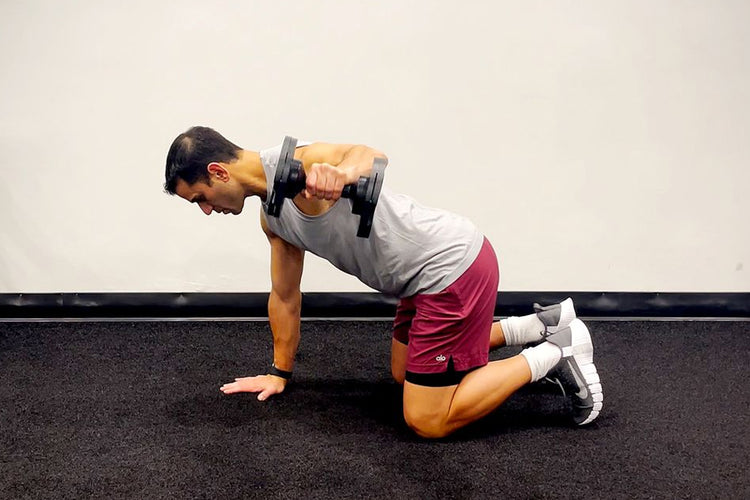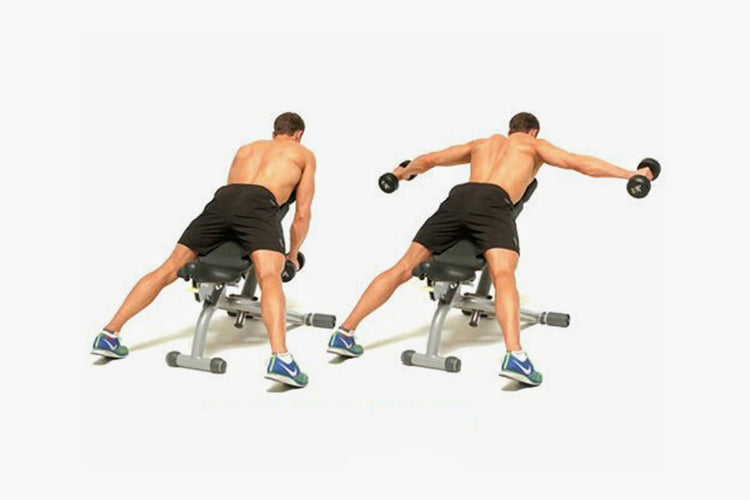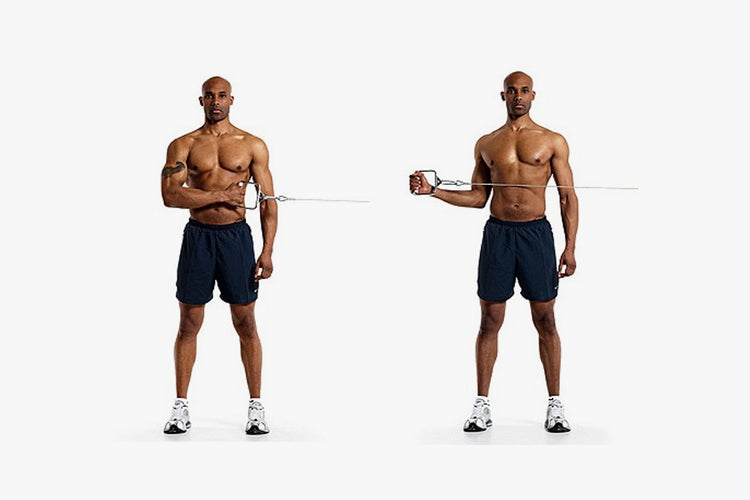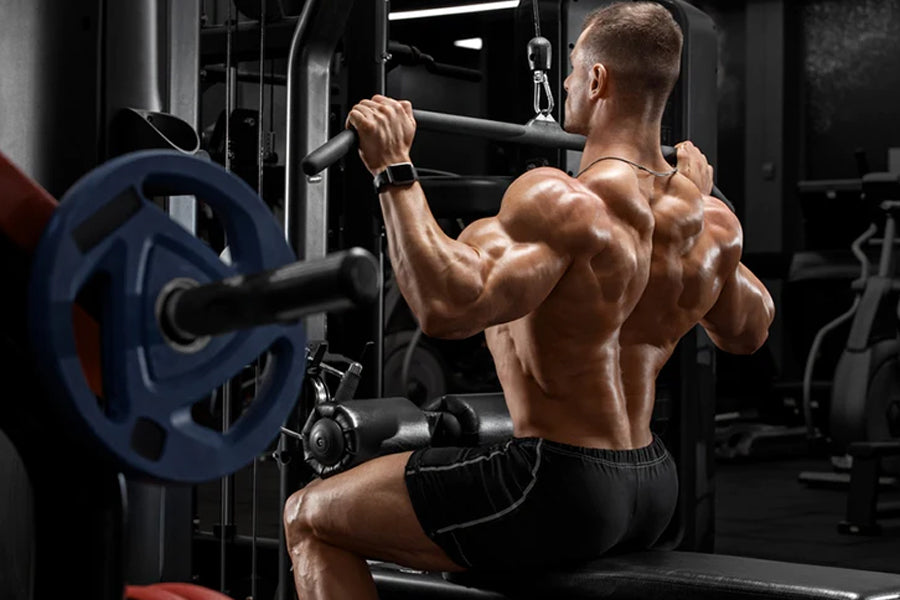Let's talk about your "pack-a-punch" posterior deltoids, AKA your rear delts. These muscles hang out in the back of your shoulder, originating on the spine of your shoulder blade and latching onto your upper arm bone.
They help extend your shoulder, and these babies are also responsible for externally rotating it. So next time you show off your guns at the gym, remember to give a little love to your rear delts for their behind-the-scenes work.
Do you remember Arnold Schwarzenegger, renowned bodybuilder and former Governor of California? He says:
"If you want to build rear deltoids, you must train them like any other body part. You cannot just focus on one group of muscles and ignore the rest. Always keep in mind that variations are essential for a well-rounded physique."
~Arnold Schwarzenegger
Say goodbye to chicken wings and hello to deltoid gains! Get the low-down on the rear delt's anatomy and discover some killer exercises to train them like a boss. Plus, let's tell you how to create a workout that'll have your rear delts begging for mercy. Get ready to flex those muscles!
What Are Rear Deltoids?

Don't worry: they're not some new designer drug. They're the muscles in the back of your shoulders! They start from the spine of your shoulder blade and connect to your upper arm bone, aka humerus. Think of them as your wingmen for shoulder action.
Your deltoids are the dynamic duo that helps to extend and externally rotate your arm, alongside the trusty infraspinatus and teres minor muscles of your rotator cuff. In simpler terms, these guys are essential for smooth and efficient shoulder movement. Without deltoids, you might be a T-rex trying to high-five. So give your shoulder muscles a pat on the back (or wherever they are) for their impressive contribution to your mobility.
Okay, so you've got the 411 on those sneaky little muscles in the back of your shoulders. But what good is knowledge without action? Let's dive into some killer exercises that'll whip those rear delts into shape. No excuses it's time to train like a boss!
Related Article: What Are Deltoid Muscles? 6 Best Shoulder Isolation Exercises for Men to Get Bigger Deltoids
What Are Some Effective Rear Delt Exercises?

Get ready to give your rear delts the workout of their dreams! We've rounded up our effective exercises for developing these muscles - introducing the quadruped rear delt raise, side-lying rear delt raise, cuff pivot, reverse fly, and pull-apart.
How do you incorporate them all into your routine? Fear not; we've got you covered. We'll break down each exercise so you can smash your rear delt goals and maximize your workout. Say goodbye to flabby delts - it's time to get toned and powerful. Let's do this!
But before jumping into action, remember to use some non-slip powder like DMoose Gym Chalk for CrossFit & Weightlifting. During weightlifting or working with bands or cable machines, our hands get sweaty due to the activation of the sympathetic system. So, let your sweat not compromise your ability to grow your rear deltoids. Keep using and rolling.
Quadruped Rear Delt Raise

Get ready to flex those rear delts! The quadruped rear delt raise is perfect for toning those hard-to-reach muscles. It doesn't require fancy equipment, so you can do it anywhere and anytime. Before you start pumping it out, remember to keep your form in check to avoid potential injuries. Keep those abs engaged, and don't let your back arch or hips rotate. With some practice, you'll raise those rear delts like a pro and see results quickly. Get ready to turn heads with your toned, firm backside!
How to Do It:
- Start on all fours with your knees and hands shoulder-width apart to perform the quadruped rear delt raise.
- Keep your spine in a neutral position and brace your core.
- From here, raise one arm out to the side of you and keep it parallel to the ground.
- Hold for a moment and then return to the starting position.
- Repeat with the opposite arm.
Side-Lying Rear Delt Raise

Want to blast those rear deltoids and achieve killer definition in your shoulders? Look no further than the side-lying rear delt raise! This exercise is the ultimate way to target the muscles that bring your arms backward and upward.
You will build serious strength, and your delts will look fierce. Before you get started, consult a qualified pro to ensure your form is on point. Get ready to take your upper body game to new heights!
How to Do It:
- Lye on one side and hold the dumbbell in hand.
- Place your head on your arm and keep your feet stacked on each other.
- Slowly raise the dumbbell before it is stacked over your shoulder.
- Control and slowly lower the weight back to the starting position.
Reverse Fly

Stop neglecting your backside with the reverse fly! This exercise is the secret weapon for working those posterior deltoids and preventing neck and shoulder pain. Forget about the front deltoids and focus on the muscles that matter for good posture.
Whether you're looking for a quick warm-up or a serious strength-training routine, the reverse fly has got your back (literally). Start with lighter weights, then proceed to heavier weights for a real challenge. Trust us your shoulders will thank you. Give them a try, and watch your posture soar!
How to Do It:
- To do a reverse fly, stand or you can also sit on a bench with feet shoulder-width apart and knees slightly bent.
- Bend forward at the butts until your torso is nearly parallel to the floor, then raise your arms to the sides leading with the elbow.
- Gradually lower your arms back to the initial position and then repeat.
Pull-Apart

Need a quick workout fix? Strengthen your back shoulder muscles with the pull-apart - an exercise you can do with a resistance band! Not only will it give you great posture, but it's also a key to healthy shoulders. And remember the satisfying stretch you'll feel in your rear deltoids! Do you know that DMoose offers Resistance Loop Bands for Workout? These incredibly lightweight and portable resistance bands allow the same muscle activity as lifting weights. At the same time, keep your shoulders strong and healthy.
How to Do It:
- Start by holding a resistance band with your palms facing each other to perform a pull-apart.
- Pull your hands apart while keeping your elbows straight, feeling the tension in the band as you do so.
- Return to the starting position and repeat for desired reps.
Cable Shoulder External Rotation

Want solid and toned shoulders? Cable External Shoulder Rotations got your back-literally! This exercise is a beast when it comes to developing the rear deltoid. You can perform this workout using a cable machine or resistance band. Get ready to flex those muscles!
How to Do It:
- Start by holding a cable attachment in your left hand with your palm facing inwards.
- From here, slowly rotate your left forearm out and away from your body until your palm faces forwards.
- Reverse the movement and repeat for the desired number of reps.
Reverse Pec Dec

Looking to beef up those posterior delts? Look no further than the Reverse Pec Dec! This exercise is a versatile gem that'll help you achieve that toned and defined look you're after. Bonus: it's beginner-friendly and uses a nifty machine, so there is no need to worry about safety concerns. Time to get those deltoids poppin'!
How to Do It:
- To perform this, take a seat on a pec dec machine the opposite way (you will be facing the machine). You can either grab the vertical or horizontal handles.
- Keep your upper back rounded as you pull the handles apart in an arc-like fashion. Bring that back just before being in line with your shoulders.
- Slowly lower the handles back to the starting position and repeat for desired reps.
Related Article: Back Day Burnout: Best Back Workout to Build Strong, Muscular & Chiseled Back
How to Prevent Injury
Don't be an overachiever, folks! Overexertion is like the evil villain of exercise, causing injuries and setbacks. When it comes to shoulder exercises, here are three golden rules to live by:
- Start slow with a lightweight and do 10-12 reps of each exercise.
- Rest for a quick minute and then repeat the circuit.
- Wrap it up with 3-4 sets of weighted rear delt raises.
But remember to chill out between sets and not push yourself too hard. The last thing you hope for is to undo all your hard work because of some muscle damage.
Why Is Strengthening Your Rear Deltoids So Important?
Your rear deltoids may seem like the forgotten muscle group, but they're the unsung heroes of your workout. Why, you ask? Well, let me tell you. Firstly, they aid in extending your shoulder - which is crucial for impressive overhead presses.
And if that wasn't enough, they also help you externally rotate your shoulder for killer moves like the Arnold press. So, make sure you give these little guys the attention they deserve.
Sculpted shoulders make all the difference, and you can thank your rear deltoids for that round, holistic look. Pay attention to these beauties to level up your fitness game and show off an overall toned physique. Time to get those rear delts into shape!
FAQs
1. What do Rear Delts do?
The posterior deltoid is responsible for the shoulder's extension, external rotation, and horizontal abduction. To stretch this muscle, reverse the action by the shoulder joint's internal rotation, flexion, and horizontal adduction.
2. How many sets should you do for rear delts?
This question has no perfect answer since everyone's physiology is different. However, 3-4 sets of 12-15 repetitions are good starting points. You can experiment with different numbers of sets and reps to see what works best for you.
3. Do rear delts respond better to high or low reps?
This question has few answers because it depends on the person's physiology and how their muscles respond to various stimuli. Generally speaking. However, when training their rear delts, most people get better results using high reps. High reps are more effective at stimulating muscle growth and hypertrophy.
The Bottom Line
Now that you've graduated from Rear Deltoid Muscle 101, it's time to put your knowledge to the test. But wait, before you start pumping iron, use proper posture and start with a reasonable weight that won't turn you into a human pretzel. Once you've nailed the basics, it's time to level up and tackle those more advanced exercises! Double-check with a personal trainer or doctor before diving into new routines. Stay safe and swole, my friend!











